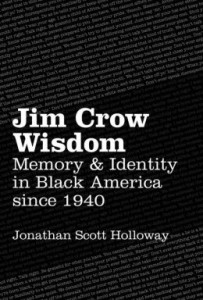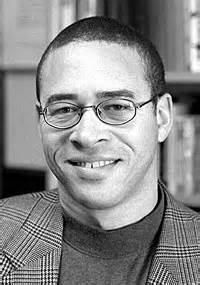Jonathan Scott Holloway. Jim Crow Wisdom: Memory and Identity in Black America Since 1940. (Chapel Hill: University of North Carolina Press, 2013)
Review by Robert J. Greene II
The intersection of memory and history has proven to be a fruitful enterprise for historians in recent years. An understanding of both is essential if scholars are to attain a proper (or at least as close to proper as possible) grasp of what both what life was like in the past, and how people thought and believed in that era. Often times, memory proves to be a forum for understanding the creation of shared traditions, customs, and identity. That is no less the case for African Americans, as Jonathan Scott Holloway argues in Jim Crow Wisdom.
The argument behind Jim Crow Wisdom is that the voice of Black America has been articulated since 1940 “through personal and public memories, academic and popular literature, dance, film, and heritage tourism, all the while examining how these ways of self-imagining are connected to a black identity that is engaged in a battle to secure full citizenship rights.” (3) Holloway, a professor of African American Studies and History at Yale, uses a variety of sources across the broad spectrum of what constitutes African American culture and scholarship to understand how memory and history both contribute to African American identity in modern U.S. society.
Why start after 1940? For Holloway, the 1940-41 period was important to the building of modern black identity in the U.S. For starters, Richard Wright’s novel Native Son was published. Months later, A. Philip Randolph began the March on Washington campaign to force President Franklin Roosevelt to move on banning discrimination in defense industries that would be, everyone knew, a key source of jobs as America geared up for entry into World War II. These moments both symbolized a new awakening of African American political, social, and cultural consciousness that shapes the cultural and intellectual production—and consumption—that Holloway details in his book.
This is in no way dismissing the attempts at cultural identity creation that came before. Holloway offers, however, a cultural and intellectual history of African American identity formation that coincides with the Civil Rights Movement, the rise and fall of Black Power, and the culture wars of the 1980s and 1990s. Holloway offers much to consider on the intersection of memory and history in this work, and his use of personal memoir merits considerable attention for the purposes of this review.
Using memoir and personal anecdotes for a work ostensibly about history can be a difficult task. Holloway, however, achieves a balance that speaks to both historians seeking a starting point for researching African American identity in the 20th century, and also to lay readers who are intrigued by a fascinating story and are willing to stick around for a good helping of historical research. Jim Crow Wisdom would have been done a serious disservice if it did not include Holloway’s personal story. Some of this you may already be familiar with if you’ve read his first book, Confronting the Veil, which was about African American intellectuals Abram Harris, E. Franklin Frazier, and Ralph Bunch during the 1920s and 1930s. His introduction for that book included brief reflections on his childhood and his educational experience. Here in Jim Crow Wisdom the memoir aspect expands to include more about the relationship between Holloway and his parents.
Memory building and identity creation, even when including the crucial roles of artists, writers, and intellectuals in creating all of that, has to begin with the family. Jim Crow Wisdom is as much about the deeply, intensely personal conversations between  Holloway and his father, an Air Force officer during the Vietnam era, about the role of race in young Jonathan’s life as he came of age. Holloway’s personal journey in academia, and a trip to Africa, also offer much to consider in regards to collective identity creation for African Americans. At the same time, Holloway offers his stories to explore larger stories of African Americans in the academy during the 1980s and 1990s, as well as displaying a keen interest in why trips to West Africa have so much appeal for African American travelers.
Holloway and his father, an Air Force officer during the Vietnam era, about the role of race in young Jonathan’s life as he came of age. Holloway’s personal journey in academia, and a trip to Africa, also offer much to consider in regards to collective identity creation for African Americans. At the same time, Holloway offers his stories to explore larger stories of African Americans in the academy during the 1980s and 1990s, as well as displaying a keen interest in why trips to West Africa have so much appeal for African American travelers.
For readers of this blog, Jim Crow Wisdom offers much in regards to the importance of intellectual history to understanding identity building. For one, Holloway delves deep into black print culture, especially the creation and early years of Ebony magazine (a topic of interest to at least several bloggers on this site). His chapter titled “Black Scholars and Memory,” however, may be the most important, as it details the long history of debate among African American academics about their role in both the academy and within the African American community. Holloway reminds us of the rich scholarship produced both for the academy and for curious non-academics in publications such as Black Scholar and Journal of Afro-American Issues. But the book as a whole is full of wonderful anecdotes and deeply researched scholarship that will allow any reader to think deeper about what we, as Americans, know and consider to be the “African American community.” Public history, popular entertainment, and scholarly journals and books form the cultural and intellectual matrix that Holloway masterfully writes about.
Where does one go from here in terms of writing about black identity? A regional aspect would be an interesting twist on Jim Crow Wisdom, looking at the ways in which North, South, East, and West divides in American cultural affect African American identity (if they do at all). Gender becomes an important part of the story, especially in regards to battles in the academy over identity. Sexual orientation, and the role it has to play in cultural identity, is a topic to be explored further in regards to the African American community. And the international aspect of African American culture and identity is a separate, but also important, topic waiting to be explored further. But these are but a few stray thoughts considering what others could do with this topic. For a rich, deep, fruitful understanding of the black cultural and intellectual experience since the middle of the 20th century, one can’t do better than Jim Crow Wisdom.

4 Thoughts on this Post
S-USIH Comment Policy
We ask that those who participate in the discussions generated in the Comments section do so with the same decorum as they would in any other academic setting or context. Since the USIH bloggers write under our real names, we would prefer that our commenters also identify themselves by their real name. As our primary goal is to stimulate and engage in fruitful and productive discussion, ad hominem attacks (personal or professional), unnecessary insults, and/or mean-spiritedness have no place in the USIH Blog’s Comments section. Therefore, we reserve the right to remove any comments that contain any of the above and/or are not intended to further the discussion of the topic of the post. We welcome suggestions for corrections to any of our posts. As the official blog of the Society of US Intellectual History, we hope to foster a diverse community of scholars and readers who engage with one another in discussions of US intellectual history, broadly understood.
Thanks for the review Robert. Having read this, I really need to check this book out. It made me think about how Ralph Ellison and Albert Murray were insistent about black wisdom under Jim Crow being a source for civil rights protest, to the point that both tended to be prickly about white liberals’ surprise that the movement got going in the South when it did. Ellison could be skeptical of any “spiritual” awakening or new “consciousness” as a result. Basically, it was already there. Murray and Ellison make it seem like schadenfreude or something (look how you smug white liberals missed folk wisdom and mother wit), but given the conclusions of Invisible Man, I wonder if that was true for Ellison, or if he was correcting after the fact. Anyhow, does Holloway talk about Murray’s “South to a Very Old Place” in there? There’s a jazz-inflected book that basically signifies on inside, Jim Crow knowledge with some pretty interesting results. As I see it anyway, Murray is playing with insider references in the way that the best jazz musicians did, that tell-tale lick made into something new in the middle of an improvisation, that sort of thing.
Thanks for the question! Murray’s not mentioned extensively in “Jim Crow Wisdom,” as far as I can remember. And it’s a shame, because as you mention he plays a serious role in talking about the ways in which African Americans preserve and create their own cultural beliefs. Murray (and Ellison) do get considerable attention in Daniel Matlin’s “On The Corner,” which is far more about how black intellectuals dealt with the urban crisis of the 1960s and 1970s. I don’t know if you’ve read that but you might find it of interest.
Thanks for the review, Robert! – TL
Thanks for reading! Loved reading this book when it first came out–reviewing it gave me a chance to think about it in depth.